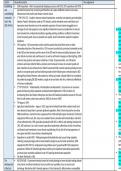Section Key points/content Key Judgements
Establishing USSR reparations – Didn’t stop physically stripping resources until 1924; 25% reparations until 1950;
and prevented economy from recovering and therefore set in place inefficient customs and a weak
consolidating infrastructure that would create future economic issues.
communist 1st 5YP (1951-55) – Sought to improve industrial production, centralise state planning and nationalise
rule in the industry; People’s Enterprises made up 75% industry, private enterprises were scaled down and
GDR 1949-61 impressive miner Hennecke was to be emulated; expansion of heavy industry struggled due to
shortages of tech and equipment, some significant industrial increases but production of coal and Econ
steel remained low, fundamental problems regarding working conditions, insufficient investment, cons
lack of consumer goods, focus on quantity over quality, Soviet intervention required to suppress plan
dissidence agric
1953 uprising – 300 construction workers (and thousands who joined them) went on strike, econ
demanding reduction of the demand for a 10% increase in productivity, protestors demanded an end econ
to the SED and free elections and the return of the SPD and the release of political prisoners, there Econ
were attacks on prisons and courthouses etc as well as anti-Soviet messages and burning flags, USSR New
arrived to stop protests and impose martial law; 21 died, 20 executed after, over 500 prison Soci
sentences and many exiled to Siberia, pensions were increased, increase in consumer goods and cons
basic reductions in price of basic items, Ulbricht announced that economic planning would give more Hon
priority to consumer goods and food rationing would end the following year; embarrassing for SED the i
although they blamed Western radio stations for stirring up trouble, allowed Ulbricht to consolidate wom
his position by purging 20k SED members, tough on law and order after this, reinforced unlikelihood Rela
of German reunification 1970
2nd 5YP (1956-59) – ‘Modernisation, Mechanisation and Automation’, focused more on consumer com
goods and improving living standards; centralised control tightened in 1958, incentives for Ostp
transforming firms into People’s Enterprises; less than 10% industrial production private in 1961 and The
third of craft workers under state control by 1960 (5x rise from 1958) reco
7YP began in 1959 the W
Agricultural collectivisation – began in 1952, large farms forfeited land whilst medium/small-sized gove
were allowed to keep theirs to prevent significant opposition, third of land relocated to more than Econ
500k beneficiaries, reluctant farmers suppressed from 1960 and high targets introduced; 15k farmers spen
emigrated to FRG in early 50s, many non-compliant farmers arrested and had land taken, only third and
of land collectivised by 1958, agricultural production fell 30% in 1960-61 and rationing introduced in Gorb
1961, SED could use it as a tool of control, agricultural production suffered due to lack of machinery the G
and livestock and resentment at some forced requisitioning of food, lack of farming experience of role
many given land led to many farmers abandoning land the S
Opposition to socialist GDR – Widespread general dissatisfaction due to poor living standards, The
rationing, housing shortages and increased taxation (largely to pay for border protection), 500k with
emigrated to FRG 1951-53; employment along skillsets wasn’t guaranteed BUT full employment Berl
guaranteed, children of industrial/agricultural workers given significant educational opportunities dism
and many basic necessities subsidised; June 1953 uprising demonstrates opposition The
The Berlin Wall built in 1961 gove
The NES (1963-68) – Government retained control of central planning but more decision-making allowed reun
development at local level, incentives introduced, focus on profits over quantities, focus on science and the a
of the East technology, Khrushchev didn’t formally approve of it but tolerated it; skilled workers overqualified acce




